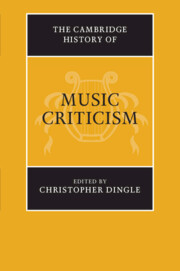Book contents
- The Cambridge History of Music Criticism
- The Cambridge History of Music
- The Cambridge History of Music Criticism
- Copyright page
- Contents
- Music Examples, Figures and Tables
- Notes on Contributors
- Acknowledgements
- Introduction
- Part I The Early History of Music Criticism
- Part II The Rise of the Press
- Part III Critical Influence and Influences
- 12 Critiquing the Canon: The Role of Criticism in Canon Formation
- 13 Comparing Notes: Recording and Criticism
- 14 The Gender Paradox: Criticism of Women and Women as Critics
- Part IV Entering the Twentieth Century
- Part V New Areas
- Part VI Developments since the Second World War
- Postlude
- Bibliography
- Index
13 - Comparing Notes: Recording and Criticism
from Part III - Critical Influence and Influences
Published online by Cambridge University Press: 21 August 2019
- The Cambridge History of Music Criticism
- The Cambridge History of Music
- The Cambridge History of Music Criticism
- Copyright page
- Contents
- Music Examples, Figures and Tables
- Notes on Contributors
- Acknowledgements
- Introduction
- Part I The Early History of Music Criticism
- Part II The Rise of the Press
- Part III Critical Influence and Influences
- 12 Critiquing the Canon: The Role of Criticism in Canon Formation
- 13 Comparing Notes: Recording and Criticism
- 14 The Gender Paradox: Criticism of Women and Women as Critics
- Part IV Entering the Twentieth Century
- Part V New Areas
- Part VI Developments since the Second World War
- Postlude
- Bibliography
- Index
Summary
It would be absurd now to suggest that recordings were not a legitimate subject for music criticism. For some genres, they are arguably the primary focus of reviews and comment, whether these appear in newspapers, magazines, journals, online or are broadcast. At the time Compton Mackenzie conceived The Gramophone in September 1922, the notion of reviewing records was far from established. Forty-five years had passed since Thomas Edison’s invention of the phonograph in 1877 and commercial recordings had started to be produced in significant quantities in the 1890s. Moreover, the years immediately after the end of the First World War saw a substantial expansion of activity for the record companies. However, according to Mackenzie’s perception in his entertaining autobiography, Robin Legge (Daily Telegraph) and Percy Scholes (the Observer) ‘were the only musical critics who had as yet recognized that such an instrument as the gramophone existed, and occasionally noticed some new record’. Nor was this situa
- Type
- Chapter
- Information
- The Cambridge History of Music Criticism , pp. 249 - 271Publisher: Cambridge University PressPrint publication year: 2019



